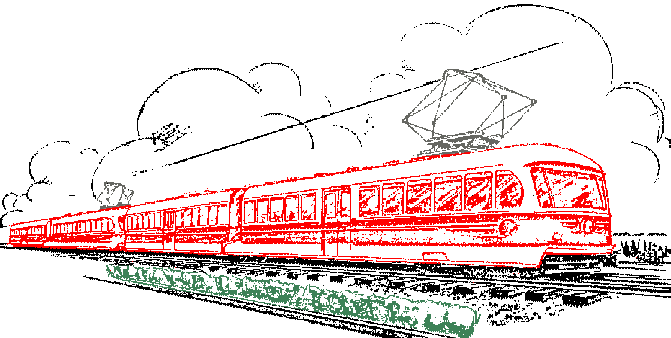

Given the politics of that era, the rapid transit plan had the backing of some strange bedfellows. The "progressive" Bowren administration, elected in a 1938 recall initiated by Clifford Clinton (of Clifton's Cafeteria) and supported by the CIO unions, was often not on speaking terms with the Los Angeles Times, but the Times, and other downtown property owners, stood to gain from the RTAG plan. RTAG member Neil Petree drew up the enabling legislation for RTAG's proposed "Metropolitan Rapid Transit District" and proposed to have the governor call a special session of the state legislature in 1948 to consider the proposal.
With the establishment of the state gas tax after the war, the region was gearing up for massive freeway construction. Thus was afforded a once-in-a-lifetime opportunity to acquire rapid transit rights of way at relatively low cost by placing them in freeway medians. As the state PUC said in a 1947 report: "It is estimated that rail rapid transit in a freeway can be provided at approximately 15% to 20% additional to the cost of the freeway alone, while a separate rapid transit system...would cost several times this amount."
Meanwhile, Pacific Electric had made clear its intention to convert to bus if the RTAG initiative failed. (In 1947 PE's bus operations made a slight profit while its rail passenger operations lost $3 million.) Los Angeles faced what was perhaps the most significant crossroads in its transportation history. The urgency was reflected in the name that RTAG chose for the brochure presenting its rapid transit plan (published in February 1948): "Rail Rapid Transit NOW!." In addition to three entirely new lines in freeways (such as the Harbor Freeway), the RTAG plan proposed to retain parts of ten PE lines as part of its new light rail rapid transit system:
"Light Rail Rapid Transit" seems the appropriate name for RTAG's proposal given that it would have combined PE surface rights of way (replete with grade crossings and low-level boarding) with grade-separated sections enjoying third-rail current collection and high-level platforms. The RTAG brochure includes a detailed description of a new generation of rail equipment to replace PE's aging fleet on the improved system. As the artist's drawing shows, the proposed rail vehicle was an articulated PCC, with a seating capacity of about 110. The design may have been influenced by the Key System articulated units used on the Bay Bridge.
The pantographs shown in the drawings were intended for operation over PE surface rights of way. Third-rail shoes would be used in long freeway sections and proposed subways in downtown Los Angeles and downtown Hollywood. Like present-day Frankfurt and Muni LRVs, the low-slung RTAG cars were to be capable of loading both from street level and car-floor-height platforms.
RTAG did not seem to envision any fundamental breakthroughs in the power of the PCC truck design. The PCC car had been designed in the '30s primarily with streetcar conditions in mind. Fast acceleration and braking were more important than top speed in the start-and-stop environment of city streets.
PE's 5000 class, which used the stock PCC truck design, had an acceleration rate of 4.5 MPH per second but a top speed of only 42 MPH. The fast acceleration taxed the 55 horsepower motors. This was not a problem in streetcar conditions where frequent stops would allow the motors to cool off. In express or interurban operation, however, sustained running could lead to motor burnout (as PE found out).
The RTAG design sacrificed some of the speedy acceleration of the original PCC design (slowing it to 3.5 MPH per second) in order to achieve a higher top speed (50 MPH) and ability for sustained running.
Other variations from the earlier PCC car design included a wider body and a single-piece "wide vision" windshield, which RTAG advocated as a safety feature.
An RTAG articulated would have weighed a bit less than a two-car train of 5000-class PCCs, given the absence of controls, couplers, doors and so on at one end of each unit. We can speculate that each articulated would have weighed in at about 39 tons (710 pounds per seat).
The lack of a forward door in the drawing seems to presuppose PE's "two-man" operation of that period, with a conductor as well as a motorman in the first car in a train. The lightweight PCC design would have helped to lower operating costs. An RTAG articulated would have had 38% more seating capacity than a PE 400-class "blimp" while weighing about 32% less.
Virtually every Los Angeles rapid transit plan prior to the 1970s projected an eventual financial breakeven point on rail operations and RTAG was no exception. Reducing PE's cost structure was essential to that goal. More efficient equipment was part of this but even more important was the reduced running time that would come from grade-separated rapid transit alignments. Faster schedule speeds would mean that fewer cars and crews would be needed to move a given passenger volume. Large articulated cars clearly could carry a higher number of passengers than the existing PE car fleet, increasing crew productivity.
RTAG estimated that a fleet
of 580 articulateds would be needed to carry the heavier ridership that would
result from faster train service and the Southland's rapid postwar population growth.
| 1992,1999 Tom Wetzel |